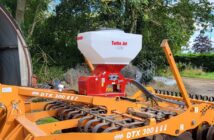Weaving will be unveiling its new 6m version of the no-till Weaving GD Drill at LAMMA 2019 – with the first view of the machine exclusively in Hall 20 on Stand 20.750. The GD6001T is being kept under wraps until day one of LAMMA, as Weaving continue to celebrate over 20 years of constructing no-till drills.
The new drill is a compact version of the GD8000T launched at Cereals 2018 and has been manufactured to meet customer demand for an operator friendly compact drill with easier setup that preserves soil structure and aids crop establishment. Key to this is a change to the coulter weight distribution – the tank is now over the coulters, allowing the coulter to be much closer to the tractor, so operators can monitor their work with greater ease.
The drill is designed for zero-tillage systems but works within conventional cultivation systems for farmers who wish to implement low disturbance farming. Everyday usage is also boosted by tighter turning, enabled by a linkage mounted drawbar and wheels installed on the back, rather than the middle.
The slicker, more efficient machine is also available in a 4 and 4.8 metre version for smaller farms.
Interest in no-till and low disturbance farming has significantly increased after Michael Gove, Environment Secretary, spoke of possibly incentivising farms to adopt no-till farming through subsidies after Brexit. Many farmers have also noted the cost savings granted by low disturbance farming in diesel, wearing parts and drilling time – all while maintaining a healthy crop and boosting soil structure.
“Weaving aims to make conservation agriculture simple,” says Simon Weaving, Sales Manager at Weaving. “The GD6001T drill puts powerful low disturbance features into a compact and modern piece of machinery, including variable seed rate and isobus controls. With farmers understanding they need to improve soil health and increase worm population, the new drill offers more compact machines while featuring wider widths – all while keeping the farmer in control of their farm, their soil health, and their bottom line.”




